Trending
Opinion: How will Project 2025 impact game developers?
The Heritage Foundation's manifesto for the possible next administration could do great harm to many, including large portions of the game development community.
To what degree are players allowed to manipulate a game's narrative elements?

Introduction
This article presents a number of maps that help to frame the relationship between game narrativity and interaction. They define narrative layers and their elements in a game and tell us to what degree they are open to player manipulation.
You may use these maps to detect
a) the "open" and "closed" parts of your game (which of the narrative elements in your game are open to manipulation and which ones are not);
b) the focus of gameplay in your game (which narrative elements is the player asked to deal with most);
c.) which narrative layers and elements you may invest more into in order to increase the joy derived from your game.
Let us have a closer look at the maps now.
I. Main Map: Narrative Layers
Classical works on narratology distinguish between four interdependent layers that form a narrative.
The first two of these layers, Events and Actants, provide the content of the narrative.
The other two layers, Narration and Narrative Situation are regarded as the form of the narrative.
Shown as a map, it looks like this:

The four fundamental layers of narratives
II. Detailed Maps: Narrative Form
Narrative Form contains the first two narrative layers: Narrative Situation and Narration.
Narrative Situation
Narrative Situation addresses the broadest parameters. We usually deal with aspects of the narrative situation when we specify overall gameplay options or when we decide on a certain game mode: For example preferring a Capture the Flag mode over a Deathmatch mode are manipulations in regard to narrative situation. They are about specifying the broadest lignes of the narrative content and its narration.
Before we start to play a session of Rise of Nations or Civilization, we are allowed to specify the settings in the game (whether we'd like to play on a single continent or over a number of islands, which time frame we prefer etc), the number of existents (how many rival nations there will be, what the population limits will be etc) and their aspects (whether special abilities are allowed or not etc), the winning conditions (under what condition the conflict will be regarded as solved) etc. Moreover we can specify sight & sound settings and change key assignments. All these operations are carried out on the narrative situation layer. Our choices will have an impact on narration and the content that will be narrated.
The bubble diagram below gives an overview of the layers of narrative form and their elements: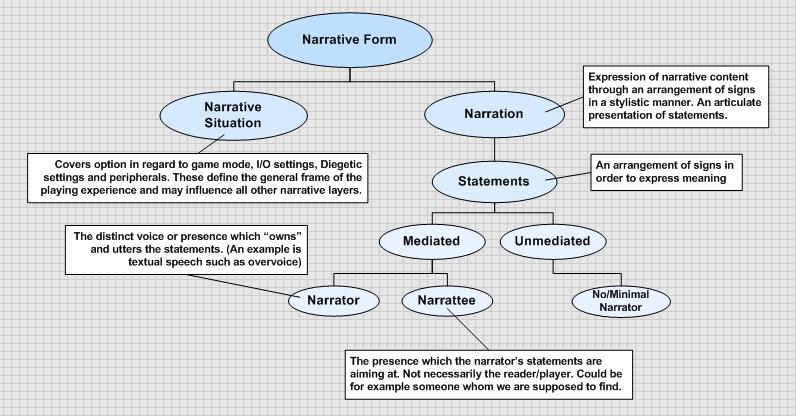
Narrative Situation and Narration explained
Narration
Narration, on the other hand is the audio-visual and tactile presentation of the fictional game universe, its existents (including the player's presence), and the events that take place in it (including the narration of and "feedback" on the player's actions and decisions).
While interaction is an distinguishing aspect of video games and often leaves the impression that there is no narration since things are done by the player in real-time, players must still be informed about their own actions and the happenings in the game world. This is an elemental part of video game narration.
Video games make use of a huge arsenal of audio-visual and tactile narration style and techniques. Some of them are based on the style and techniques of previous media, whereas others may be regarded as being unique to video games.
A game that allows us to modify the ways in which sight, sound and other types of information are presented to us can be regarded as being open to manipulation on the narration layer. Examples would be Need for Speed, in which we can switch between first-person and third-person perspective, or Counter-Strike, in which we can modify the angle of our perspective by moving the cursor.
Statements
Statements are medium-dependent, that is, every medium has its unique possibilities and limitations in expression.
Narration consists of Statements which may be mediated and unmediated, that is, they may be expressed through the voice of a narrator or not. In many games we will find a mix of unmediated and mediated statements.
In cases in which the statements are mediated, they are voiced by or hint at a narrator whose speech addresses a narrattee.
Mediated and Unmediated Narration
A lot of games seem to be narrated eclusively through unmediated statements, that is, they make minimal or no use of a narrator. Instead of a verbal account of things, they go for a "simulation of events". Indeed, most "formal" games (like for example Tetris) are of this kind.
The text adventure genre on the other hand, can be given as an example in which mediated narration is preferred. In such games, the presence of a narrator and a narrattee is often very easy to detect. The narrator would simply say things like "You [the narrattee] stand in front of a closed door."
But we should always be prepared to find a mix of mediated and unmediated statements: In a game that went with unmediated statements for a long time, you suddenly may come accross a mediated statement (and vice versa). In Railroad Tycoon 2 for example, for most parts of the game, narration is based on the simulation of events and supported with frequent appearances of newspaper headlines etc. It is difficult to trace down a narrator in all this. Thus, the ongoing narration may be regarded as to be built around unmediated statements. Yet at certain moments, a narrator pops up and gives us an account of things: "The city council of Pittsburg offers you 200 K if you connect to their city before 1872. Do you accept?"; or "Good job. You've connected to Chicago. You can still earn a bronze if you connect to Denver before 1879" etc. Also the intro scene of a new game level welcomes us with the speech of another narrator; an old Southerner with a torn voice. He comments about our good work in the past level, and warns us about the challenge we will face in the next one.
Pro Evolution Soccer or FIFA, in which players can turn on or off in-game commentary, the choice is in regard to whether we want a match to be accompanied by a narrator, that is, the presense of flow of mediated statements.
Narrators and Narratees
Football Manager is a good example of how complex it can become in regard to the presence of narrators. This game uses mediated statements throughout the communication that takes place on the message boards. Here, one of the narrators uses statements like "Your assistant informs you that..." whereas our assistant might have spoken directly to us. Another narrator uses the register of sports news portals. Yet another narrator is the match commentator that accompanies with his comments the simulated events that take place during a match.
Games that allow us to turn off tutorials are often examples for at least one narrator in the story being eliminated.
We must distinguish between pure narrators and character-narrators. Some narrators may not be involved into the events that take place, but they may be still all-knowing about them, while others may be actively involved into the ongoing events, but yet possess limited information on the situation. An example for the latter would be Max Payne, in which the protagonist is the narrator of the mystery that he tries to solve.
When a narrator is involved, his statements are always directed towards a narrattee, that is, someone whom the speech is addressing. The narrattee isn't necessarily the player, but may be some other character in the game world.
The Sims is an interesting example because it allows players to narrate the lives of their characters by adding character descriptions. That means that the player may add a narrator to the story. This narrator (which could be simply the player's self) may pretend to know the truth about the otherwise only simulated characters and events, and once this narrator gives a recount, she has already addressed a narratee (which might simply be again the player's self).
While modern games give us a lot of freedom in modifying the parameters of narration, we must remember that just two decades ago this was rather rare. For example the majority of classic arcade games do not allow for manipulations on the narration layer: In games such as Centipede, Pac-Man or Space Invaders the audio-visual style and the aestetic parameters of the statements that are produced through them are not manipulable. We have no option in regard to change whether the statements are mediated or unmediated. We have no chance to manipulate the number of narrators and the style and content of their recount, nor can we modify anything on the narrattee's side.
The bubble diagram below shows us what questions may be asked in order to tell the openness of manipulation of narrative form.
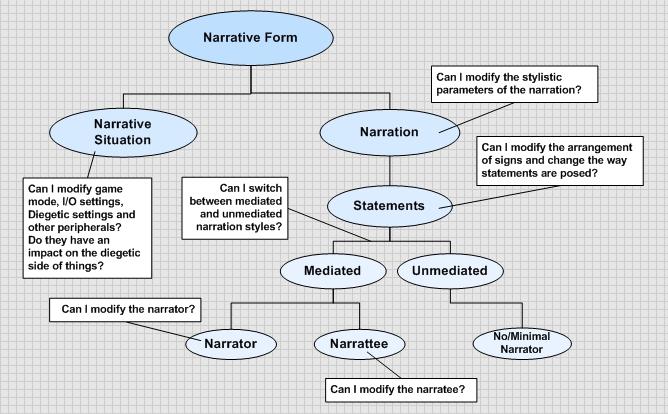
Narrative Situation and Narration - Questions in regard to interaction
III. Narrative Content: Actants
Actants are the characters and the settings that play a central role in the maintenance of the plot. Actants possess a degree of functionality in making the plot progress. Central to this are the actions they carry out, and how central these actions are in deciding the outcome of the narrated sequence of events.
Degree of Importance to the Plot
A good example for the degree of importance to the plot is how we perceive our encounter with ordinary enemies and with bosses. Ordinary enemies are often just some "loot bags" to us, we often use words like "cannon fodder" when we speak of them and by doing so, we address their degree of importance to the plot. On the other hand, the encounter with a boss is perceived as a milestone in the progress that we make. We consider this as a core event which also reveals that the boss type of actants have a degree of importance to the plot. Oviously, the actant with the highest degree of importance to the plot is our own actant.
The same counts for settings. In Rise of Nations for example, some environmental elements and existents may have no big importance to the plot, whereas resource areas are central to it.
Aspect
Aspect is in regard to the identity and qualities of the actants, such as their moods and traits. These may be detailed or shallow, depending on the game we play. Also the type of narration sets a limit on how much we know about the aspect of actants. For example in large parts of Duke Nukem we have not much knowledge about the physical appearance of Duke due to the first-person perspective that the narration is visually build around (until we come accross a mirror!).
Sometimes the aspect of actants may only become only visible through their actions. For example in Tetris, the player is an actant that becomes visible through his decisions in regard to how he moves and places blocks; whereas the "antagonist" becomes visible through his choices in regard to which block to send next. "It" challenges us by sending the blocks faster and faster, often denying us the block that we are in need of to clean the level. All these reveal aspect to a certain degree.
On the other hand, a lot of games provide us with a lot of information about the aspects of actants. In Football Manager for example, you may find information about the identities of managers and footballers, and the statements they release in the press tell us about their moods and traits. Some will always apologize when you fine them for unproper conduct whereas others will be very rejective and immediately demand to be put on the transfer list. Actually, the FM Editor provides a database that allows us to overwrite the aspect side of actants: You may change a soccer players identity, his mood (level of aggression), and his traits (likes to the chip the ball, or likes to play it around the keeper etc.) and all these will have an impact on how events will play out.
Actants Layer explained
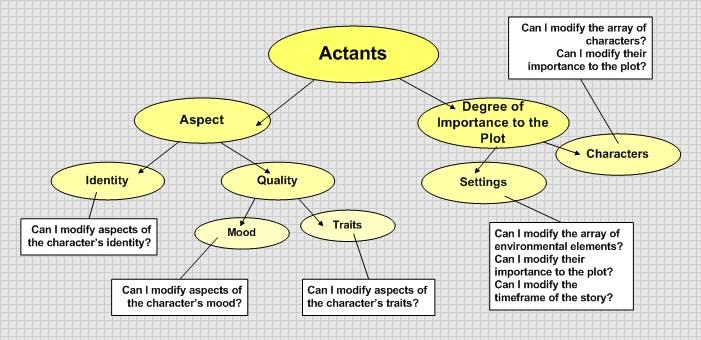
Actants layer - Questions in regard to interaction
IV. Narrative Content: Events
Events typically include the actions and happenings in the story. Whether an event is an action or a happening depends on agency, that is, the answer who carries out the action, and who is subject to it.
On the other hand, necessity marks how central an event is to the plot. An event that can be skipped or ommitted without making the narrative as whole collapse, is a sattelite, whereas an event that opens a gap in the logic and chronology when removed from the narrative, is a kernel.
Agency
Actions are the things done by actants. Happenings on the other hand are those things that happen to characters. The difference lies in agency. It must be understood that often one actants's action equals to a happening for the actant subject to that action. For example in a multiplayer FPS, an action is when I shoot at someone, whereas for the player that is my target, the same thing is a happening.
In most single player games, players deal with the actions part, whereas the AI cares for the happenings. In Sim City for example, the actions are centered around the players decisions in regard to how to build the city, whereas the majority of other events comes in form of happenings: Traffic, smog, riots, disasters, crime rates, advisors speaking to us etc.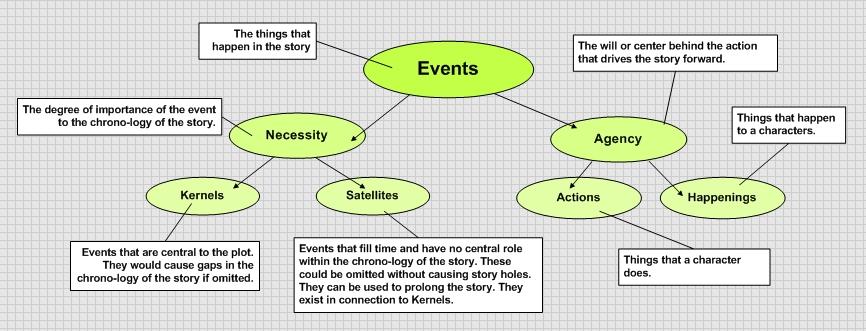
Events explained
Necessity
Events are categorized based on the level of necessity they possess. Some events are core to the story, that is, if we'd leave them out, the experience feels incomplete, as if it were truncated. The narrative simply wouldn't be able to maintain itself without that event. Certain quests or cutscenes are kernels, because when we skip them, we may not be able to obtain a key that is necessary to unlock another level, or we may miss an important information that may be later on necessary to solve the conflict.
Sattelites, on the other hand, are complementary, but not necessary. For example we can skip quite a lot of quests or cutscenes because the events they contain are sattelites, not kernels. The narrative can live without them. We may ask the following questions in regard to the events layer:
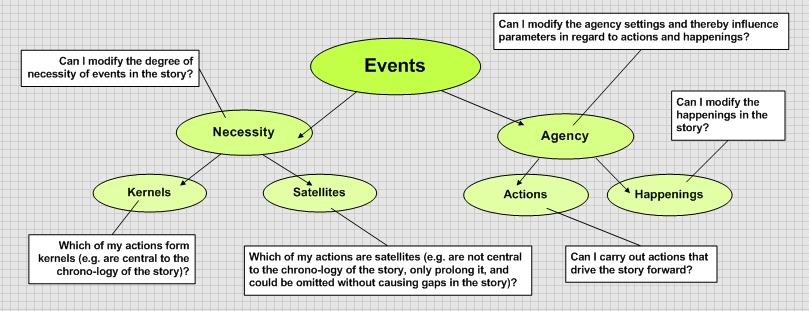
Events layer - Questions in regard to interaction
Historically, video games have been always open to manipulation on the events layer, even though to a limited degree: The archetype of video game interactivity has been the manipulation of actions. The player was given a minimum of agency by being allowed to decide on the actions carried out by an actant.
However, modern video games allow players for more than just carrying out actions. They may allow players to decide whether they want to be put through satellites (skipping cutscenes; choosing a save point to start from, being allowed to skip entire levels); they may allow to alter the freqrency of certain happenings (setting the traffic level in Need for Speed, or setting the frequency of train robberies in Railroad Tycoon 2), and they may allow to put constraints on certain actions (disabling or enabling special moves) etc.
V. Interaction Chart
The chart below present a summary of the questions we might ask about the narrative layers in a game and their degree of openness to interaction.
The questions are general, but they might be refined depending on the particular game that is being analysed.
Interaction Chart
As a designer, you may use this chart to ask testers and gameplayers about the experience they have with the game. The feedback these players provide to you may help you to assess the narrative aspects that they are happy or unhappy with in your game.
You may also use it in design meetings with other designers to discuss certain aspects of the game that you are developing together.
As game researchers you simply may use this chart to see how certain games deal with their narrative layers. You may also apply it in historical studies, trying to follow the evolution of certain platforms or genres in regard to their openness to manipulation of particular narrative layers and their elements.
Note:
The model of narrative layers presented in this article is based on the works of Seymour Chatman and Roland Barthes.
Read more about:
BlogsYou May Also Like